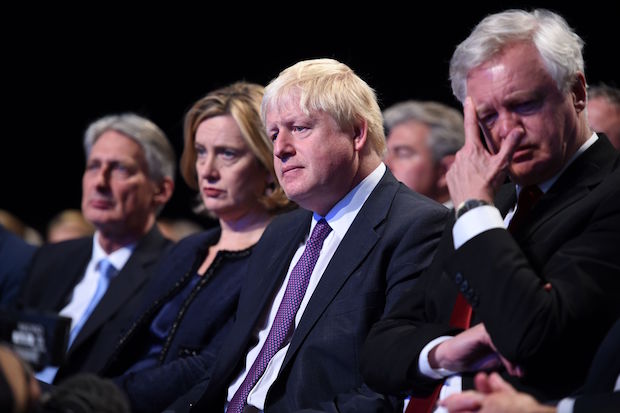Good news in Downing Street: Theresa May has survived the weekend. After the Shapps plot failed to take off, the new consensus is that the beleaguered Prime Minister should re-assert her authority on an increasingly unruly Tory party by reshuffling her Cabinet. Had the speech gone better, there was talk that she could have done this last week. The Sunday Times reports that a shuffle is now likely to occur after the European Council meeting in two weeks’ time.
If May does oblige, there are calls from within the party for her to use a reshuffle to promote younger talent – and to sack the Foreign Secretary. The latter still looks unlikely. Although the Prime Minister is doing little to cool speculation about Boris Johnson’s job prospects – ‘it has never been my style to hide from a challenge and I’m not going to start now’ – firing him is risky.
Johnson’s outspoken behaviour in recent weeks (sharing his vision for Brexit with several national papers) is only likely to increase if he is outside government with little reason to behave. What’s more, even demoting Johnson to a lesser Cabinet role could result in many Brexiteers deciding May has gone soft and taking action to line-up a more hardline Brexiteer for leader.
Ultimately the same factors that dissuaded her from carrying out a revenge reshuffle after the election remain – her position is too fragile to rock the boat. To trigger a vote of confidence, just forty-eight Conservative MPs (15pc of the party) need to write to the 1922 chairman backing a no confidence vote in Theresa May. While the majority of the party are still behind her, it’s entirely possible that a rejected ex-minister hell bent on revenge could rouse enough support with the help of outed rebels like Grant Shapps. It follows that May would need to pick very carefully who to fire in order to not also put herself out of a job.
As I’ve asked before, who can she actually sack? Brexit is at such a crucial point that playing musical chairs with any of the great offices of state could be costly. So, rather than risk a backlash on either the Remain or Brexit side by trying to axe figures such as Johnson or Philip Hammond, May could look to her allies. Perversely, firing her friends could be her best option. Karen Bradley – a key May ally who played a role in her leadership campaign – is too loyal to her boss to fire off a letter to Brady if given the chop. Likewise, Patrick McLoughlin – the party chairman – is said to have already offered his resignation, after the election result. Such moves could also make room for younger MPs to be brought in for junior ministerial roles.
If May does use a reshuffle to give younger MPs the chance to gain ministerial experience and prove themselves, she will rejuvenate her party both in the short and long term. After a flat conference where the main hall was half empty most of the time, it’s clear the current Cabinet does not inspire. By making room for new talent, she will also give young Turks the chance to prove themselves – just as Michael Howard did after the 2005 general election – ahead of an eventual leadership contest. Such a move will be far more warmly received within the party than a reshuffle that looks like a personal vendetta.







Comments